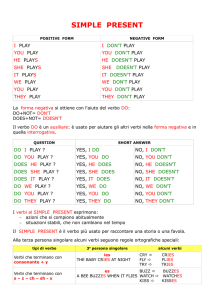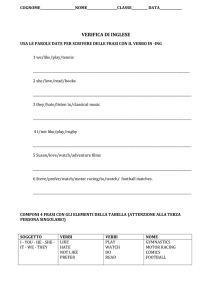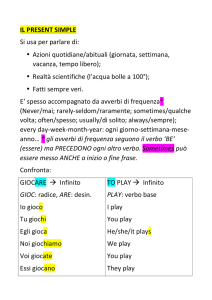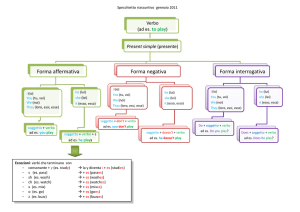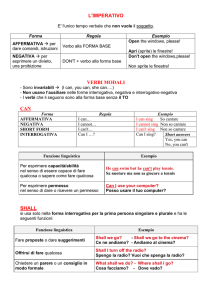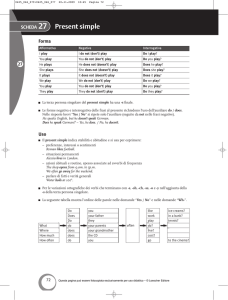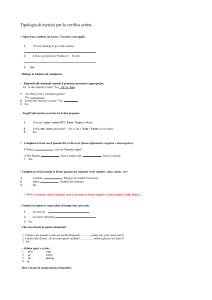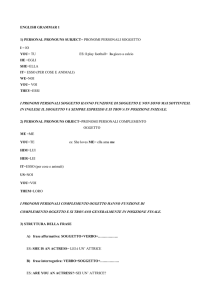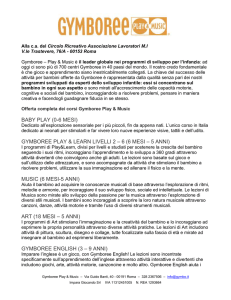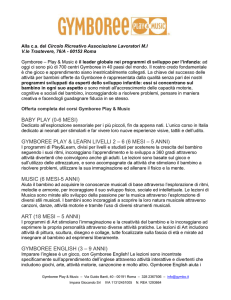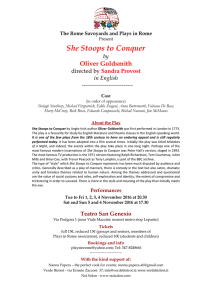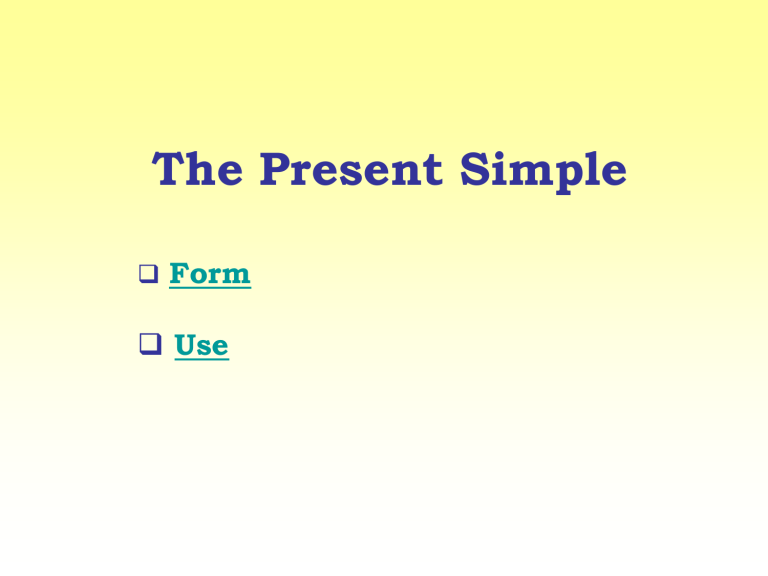
The Present Simple
Form
Use
Use
Si usa per parlare di azioni abituali,
situazioni permanenti e dati di fatto.
Ex.
I work every Saturday. (AZIONE ABITUALE)
My grandmother lives in London.
(SITUAZIONE PERMANENTE)
Dogs eat meat.
(DATO DI FATTO)
N.B. Il Present Simple spesso è accompagnato
da AVVERBI DI FREQUENZA o espressioni
avverbiali di frequenza.
Avverbi di frequenza
Always
Often
Usually
Sometimes
Rarely
Never
si inseriscono tra
soggetto e verbo
She usually watches TV in the evening.
They never go to church.
Espressioni avverbiali di frequenza
Every day
TUTTI I GIORNI
Once a day/week/month/year/…
UNA VOLTA AL GIORNO/SETTIMANA/MESE/ANNO/…
Twice a day/week/month/year /…
DUE VOLTE AL GIORNO/SETTIMANA/MESE/ANNO/
Three times a day/week/month/year/
TRE VOLTE AL GIORNO/SETTIMANA/MESE/ANNO/…
I go to work every day.
We play tennis twice a week.
fine
frase
Form
FORMA AFFERMATIVA
Si ottiene dalla forma base del verbo
(cioè dall’infinito senza il TO)
Ex.
To play
INFINITO
play
FORMA BASE
I play
PRESENT SIMPLE
Il Present Simple è uguale per tutte le persone tranne
alla 3° persona singolare (HE–SHE–IT) in cui si
aggiunge –S.
Ex.
play
live
eat
he plays
she lives
it eats
ECCEZIONI: alcuni verbi subiscono delle variazioni
ortografiche nella formazione della 3° persona
singolare.
I seguenti verbi non aggiungono normalmente
–S alla 3° pers. sing., ma:
I verbi terminanti in:
S
SH
CH
X
O
aggiungono –ES
kiss
kisses
wash washes
catch catches
mix
mixes
go
goes
I verbi terminanti in CONSONANTE + Y trasformano
la Y in I e aggiungono –ES:
marry marries
study studies
Pertanto alla forma affermativa si avrà:
I play
You play
He plays
She plays
It plays
We play
You play
They play
FORMA INTERROGATIVA
Si ottiene con l’ ‘ausilio’ degli ausiliari
DO e DOES. Si segue questo schema:
Per tutte le persone tranne la 3° sing.:
DO
+
SOGGETTO
+
FORMA BASE
?
Per la 3° persona singolare (he – she - it):
DOES
+ SOGGETTO + FORMA BASE ?
Ex.
Do they watch TV?
LORO GUARDANO LA TV?
Does he study English?
LUI STUDIA L’INGLESE?
N.B.: DO e DOES non si traducono in italiano.
Do e Does sono sempre il primo elemento nelle
domande tranne quando nella domanda vi sono le
QUESTION WORDS che hanno la precedenza su
tutti gli altri elementi.
Question words
Who? CHI?
Who do you want to see?
What? COSA/QUALE (fra molti)? What does this word mean?
Which? QUALE (fra pochi)?
Which one do you prefer?
When? QUANDO?
When does it finish?
Where? DOVE?
Where does she live?
Why? PERCHE’?
Why do you study English?
How? COME?
How do you spell that?
How many? QUANTI/E?How many languages do you speak?
How much? QUANTO/A?
How much does it cost?
How often? QUANTO SPESSO? How often do you play golf?
What time? A CHE ORA? What timedoes the lesson start?
Pertanto alla forma interrogativa si avrà:
Do I play?
Do you play?
Does he play?
Does she play?
Does it play?
Do we play?
Do you play?
Do they play?
Forma negativa
Si ottiene con l’ausilio di DON’T
(DO+NOT) e DOESN’T (DOES+NOT). Si
segue il seguente schema:
Per tutte le persone tranne la 3° pers. sing.:
SOGGETTO +
DON’T
+
FORMA BASE
Per la 3° pers. sing. (he – she – it):
SOGGETTO
+
DOESN’T
+
FORMA BASE
Ex.
They don’t read newspapers.
LORO NON LEGGONO QUOTIDIANI.
She doesn’t teach* Maths.
LEI NON INSEGNA MATEMATICA.
* N.B.: dopo gli ausiliari DO e DOES il verbo
è sempre alla forma base.
Pertanto alla forma negativa si avrà:
I don’t play
You don’t play
He doesn’t play
She doesn’t play
It doesn’t play
We don’t play
You don’t play
They don’t play

